Fast Facts
John "Dr. Lightning" Jensenius, retired NWS Meteorologist, created a PDF "Cloud Book" called Clouds Outside my Window.
Clouds Outside my Window is available for free. The end of the book contains a link to a PowerPoint template to make your own "Clouds Outside my Window" book.
Fast Facts
John "Dr. Lightning" Jensenius, retired NWS Meteorologist, created a PDF "Cloud Book" called Clouds Outside my Window.
Clouds Outside my Window is available for free. The end of the book contains a link to a PowerPoint template to make your own "Clouds Outside my Window" book.
Luke Howard noticed that clouds often have features of two or more categories, such as cirrus + stratus, cumulus + stratus, etc. Based on these observations, he suggested modifications (or combinations) of the core four clouds between categories. This research served as the starting point for the ten basic types of clouds we observe.
From the World Meteorological Organization's (WMO) International Cloud Atlas, the official worldwide standard for clouds, the following are definitions of the ten basic cloud types, divided by their height:
High-Level Clouds
Cirrus (Ci), cirrocumulus (Cc), and cirrostratus (Cs) are high level clouds. They are typically thin and white in appearance, but can appear in a magnificent array of colors when the sun is low on the horizon.
Cirrus (Ci)
Detached clouds in the form of white, delicate filaments, mostly in patches or narrow bands. They may have a fibrous (hair-like) and/or silky sheen appearance.
Cirrus clouds are always composed of ice crystals, and their transparent character depends upon the degree of separation of the crystals. As a rule, when these clouds cross the sun's disk, they hardly diminish its brightness. When they are exceptionally thick, they may veil its light and obscure its contour.
Before sunrise and after sunset, cirrus are often colored bright yellow or red. These clouds are lit up long before other clouds and fade out much later; some time after sunset they become gray.
At all hours of the day, cirrus near the horizon are often of a yellowish color. This is due to the distance the light travels through the atmosphere at a low angle.
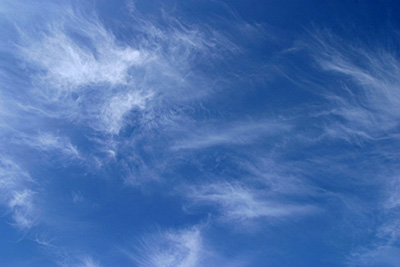
Cirrocumulus (Cc)
Thin and white, these clouds look like a patchy sheet or layer arranged somewhat-regularly into grains or ripples without shading. Most of these elements have an apparent width of less than one degree (approximately width of the little finger held at arm's length).
Predominantly made of ice crystals, cirrocumulus often form in connection with cirrus or cirrostratus or from a degraded state of these cloud types and are short-lived.
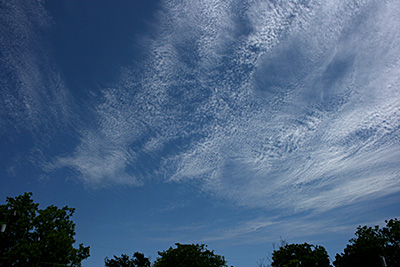
Cirrostratus (Cs)
Transparent, whitish veil-like clouds with a fibrous (hair-like) or smooth appearance. A sheet of cirrostratus is very extensive and can cover the whole sky.
During the day, when the sun is sufficiently high above the horizon, the sheet is never thick enough to prevent shadows of objects on the ground.
A veil of cirrostratus may have a similar appearance to a milky veil of fog (or thin stratus), but is distinguished by a halo phenomena nearly always produced around the Sun or Moon shining through a layer of cirrostratus.
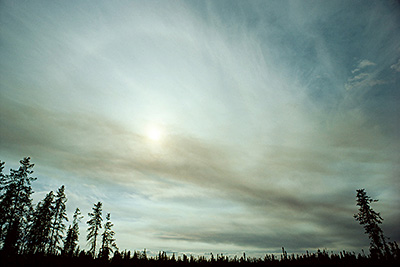
Mid-Level Clouds
Altocumulus (Ac), altostratus (As), and nimbostratus (Ns) are mid-level clouds composed primarily of water droplets. However, they can be composed of ice crystals when temperatures are low enough.
In Latin, alto means 'high' yet altostratus and altocumulus clouds are classified as mid-level clouds. 'Alto' is used to distinguish these "higher-level" clouds from their low-level liquid-based counterpart clouds, stratus and cumulus.
Altocumulus (Ac)
White and/or gray patchy, sheet, or layered clouds generally composed of laminae (plates), rounded masses, or rolls. They may be partly fibrous or diffuse and may or may not be merged.
Most of these regularly arranged small elements have an apparent width of one to five degrees (larger than the little finger and smaller than three fingers held at arm's length).
When the edge or a thin semitransparent patch of altocumulus passes in front of the sun or moon, a corona appears. This colored ring has red on the outside and blue inside and occurs within a few degrees of the sun or moon.
The most common mid-level cloud, multiple layers of altocumulus often appear at different levels at the same time. Many times, altocumulus will appear with other cloud types.
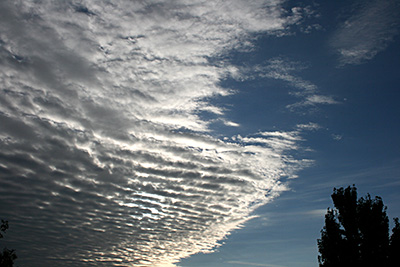
Altostratus (As)
Gray or bluish cloud sheets or layers of striated or fibrous clouds that totally or partially cover the sky. They are thin enough to regularly reveal the sun as if seen through ground glass.
Altostratus clouds do not produce a halo phenomenon nor are the shadows of objects on the ground visible.
Sometimes virga (streaks of rain) is seen hanging from altostratus and at times may even reach the ground, causing very light precipitation.
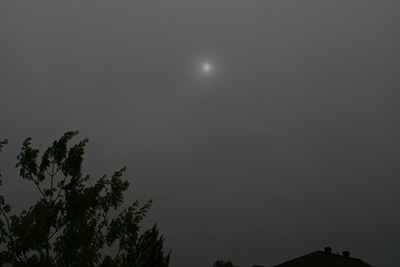
Nimbostratus (Ns)
Resulting from thickening altostratus, this is a dark gray cloud layer diffused by falling rain or snow. It is thick enough throughout to blot out the sun. Low, ragged clouds frequently occur beneath this cloud and sometimes merge with its base.
The cloud base lowers as precipitation continues. Because of the lowering base, it is often erroneously called a low-level cloud. Both altostratus and nimbostratus can extend into the high level of clouds.
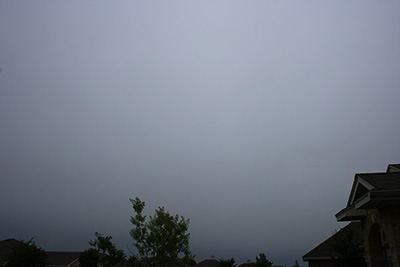
Low-Level Clouds
Cumulus (Cu), stratocumulus (Sc), stratus (St), and cumulonimbus (Cb) are low clouds composed of water droplets. Cumulonimbus, with its strong vertical updraft, extends well into the high level of clouds.
Cumulus (Cu)
Detached, generally dense clouds and with sharp outlines that develop vertically in the form of rising mounds, domes, or towers with bulging upper parts often resembling a cauliflower.
The sunlit parts of these clouds are mostly brilliant white while their bases are relatively dark and horizontal.
Over land, cumulus develops on days of clear skies due diurnal convection. It appears in the morning, grows, and then more or less dissolves again toward evening.
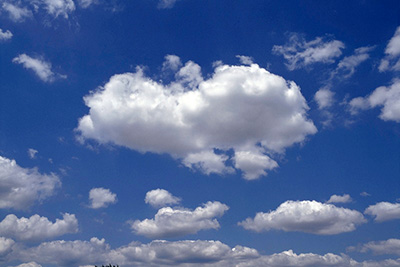
Cumulonimbus (Cb)
The thunderstorm cloud, this is a heavy and dense cloud in the form of a mountain or huge tower. The upper portion is usually smoothed, fibrous, or striated and nearly always flattened in the shape of an anvil or vast plume.
Under the base of this cloud, which is often very dark, there are commonly low ragged clouds that may or may not merge with the base. They produce precipitation, which sometimes is in the form of virga.
Cumulonimbus clouds also produce hail and tornadoes.
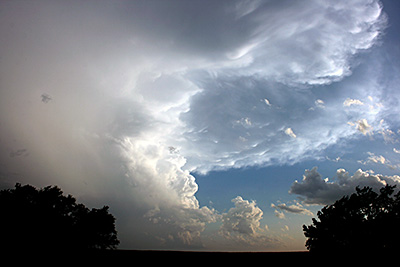
Stratocumulus (Sc)
Gray or whitish patchy, sheet, or layered clouds that almost always have dark tessellations (honeycomb appearance), rounded masses, or rolls. Except for virga, they are non-fibrous and may or may not be merged.
They also have regularly arranged small elements with an apparent width of more than five degrees (three fingers at arm's length).
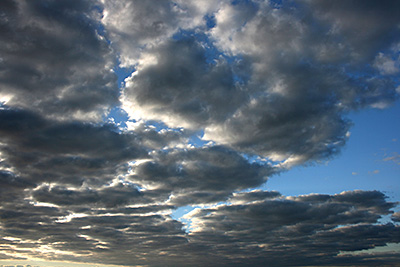
Stratus (St)
A generally gray cloud layer with a uniform base which may, if thick enough, produce drizzle, ice prisms, or snow grains. When the sun is visible through this cloud, its outline is clearly discernible.
Often, when a layer of stratus breaks up and dissipates, blue sky is seen.
Sometimes appearing as ragged sheets, stratus clouds do not produce a halo phenomenon except, occasionally, at very low temperatures.
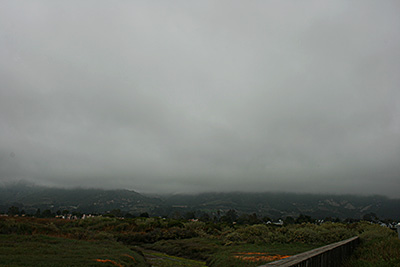
Learning Lesson: A 'Hole' Lot of Clouds 2
Learning Lesson: Head in the Clouds
Fast Facts
John "Dr. Lightning" Jensenius, retired NWS Meteorologist, created a PDF "Cloud Book" called Clouds Outside my Window.
Clouds Outside my Window is available for free. The end of the book contains a link to a PowerPoint template to make your own "Clouds Outside my Window" book.


